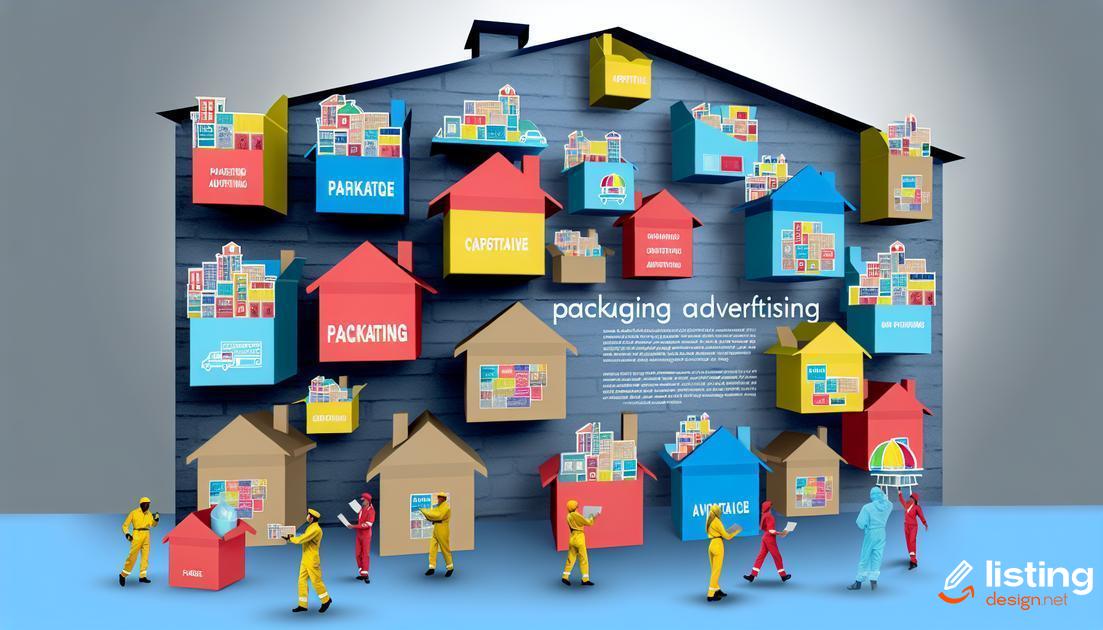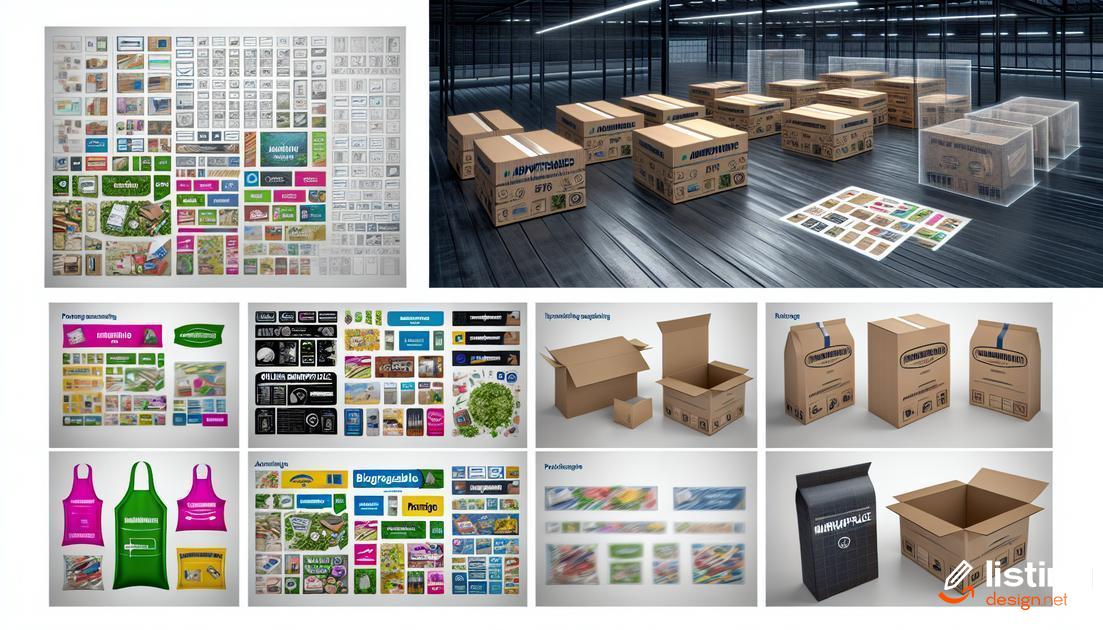Advertising on Amazon packaging is a powerful way to enhance your brand’s reach and visibility. With millions of packages delivered daily, this method of advertising taps into a vast audience. It offers unique opportunities to capture customer attention right at their doorstep. Our guide explores crucial aspects, from benefits and design tips to measuring impact and avoiding common mistakes.
Table of Contents
Why Choose Amazon Packaging for Advertising?
Benefits of Advertising on Amazon Packaging

Advertising on Amazon packaging offers a multitude of advantages for brands looking to increase their visibility and reach a wider audience. One primary benefit is targeted exposure, as your ads are seen by customers who have already made purchases, indicating a higher intent to buy similar products.
Another advantage is the captivating and unavoidable nature of these advertisements. When a customer receives a package, your ad is directly in front of them, guaranteeing that it won’t be missed in the clutter of digital marketing.
Additionally, Amazon’s extensive reach gives your brand the opportunity to engage with a diverse audience globally. This opens up new markets and demographics that might have been difficult to access otherwise.
Advertising on packaging also enhances brand recall. When customers repeatedly see your brand on packages, it reinforces your brand presence and fosters better memory retention.
Lastly, this form of advertising can lead to an increase in customer loyalty. By associating your brand with a trusted and reliable platform like Amazon, customers may feel more inclined to trust and purchase from your brand again in the future.
How to Get Started with Amazon Package Ads
Choosing the Right Product
Start by selecting the specific products you want to advertise through Amazon package ads. Focus on popular and high-demand products that can catch a customer’s eye when they receive their package. Use data analytics and market research to identify suitable candidates.
Creating Your Advertisement
Design your ad with compelling visuals and clear, concise messaging. Ensure that the ad highlights key benefits and unique selling points. Incorporating your branding elements such as logos, brand colors, and fonts can increase recognition.
Submission Process
Submit your ad to Amazon’s advertising platform. Adhere to Amazon’s specifications, ensuring your content complies with design guidelines and content policies. This might include image resolution, file format, and acceptable messaging.
Setting Target Parameters
Decide who will see your ads by setting precise target demographics. Consider factors like geographic location, purchasing behavior, and customer interests. Targeting helps ensure your ads reach potential customers more likely to convert.
Budgeting and Bidding
Determine your budget and bid amounts. Amazon package ads work on a bidding system where you will need to set a maximum bid for your ad placements. It’s essential to balance between competitive bids and staying within your budget.
Monitoring and Optimization
After your ads go live, continuously monitor their performance. Track metrics such as click-through rates (CTR), conversion rates, and cost-per-acquisition (CPA). Use this data to tweak and optimize your ads for better performance.
By following these steps, you can create effective Amazon package ads that enhance brand visibility and drive customer engagement.
Types of Advertisements for Amazon Packaging

Amazon packaging offers various advertising possibilities to help brands stand out. Here are some popular types:
1. Printed Ads
Printed advertisements directly on the packaging can include logos, product images, promotional messages, or QR codes. These ads are visible immediately upon delivery, making them a powerful branding tool.
2. Insert Ads
Inserts are additional materials included inside the package. These can be flyers, brochures, or discount coupons that encourage repeat purchases or drive traffic to your online store.
3. Sticker Ads
Stickers on the outside of the package can provide promotional messages, discount codes, or special offers. They are affordable and can be customized easily.
4. Influencer Collaborations
Collaborate with influencers to include personalized messages or products in the package. This type of advertising adds a layer of trust and engagement, enhancing customer experience.
5. Seasonal Campaigns
Utilize special packaging designs for holidays or events to attract attention. Seasonal ads can make your products more appealing to consumers looking for festive or themed items.
6. Eco-friendly Ads
Promote your brand’s sustainability efforts right on the packaging. Highlighting eco-friendly practices can resonate with environmentally-conscious customers and boost your brand’s image.
Design Tips for Eye-Catching Package Ads
[object Object],[object Object],[object Object],[object Object],[object Object],[object Object],[object Object],[object Object],[object Object],[object Object],[object Object],[object Object],[object Object],[object Object],[object Object]Best Practices for Effective Amazon Packaging Ads

When implementing best practices for effective Amazon packaging ads, it is important to focus on several key elements that will help maximize the visibility and impact of your advertisements.
Quality Design and Branding
Ensure that your packaging ads are visually appealing and consistent with your brand’s identity. Clean, high-resolution images and a cohesive color scheme can make your ad stand out.
Clear and Compelling Messaging
Craft messages that are straightforward yet persuasive. Use clear, concise headlines and provide essential information without overwhelming the audience. Highlight unique selling points to attract attention.
Strategic Placement
Consider the placement of your ads on the packaging. Optimize areas that are most likely to be seen by customers, such as the front-facing sides of the package. Ensure the visibility of important information by placing it in prime spots.
Call to Action
Include a strong call to action (CTA) to guide customers towards the desired next step. Use actionable phrases like ‘Shop Now’ or ‘Learn More’ to encourage engagement.
Testing and Optimization
Regularly test different ad designs and messaging strategies to see what resonates best with your audience. Analyze the performance of your ads and make data-driven adjustments to improve effectiveness continuously.
Following these best practices can help you create highly effective Amazon packaging ads that grab attention and drive consumer action.
Case Studies: Success Stories of Package Advertising
Discover how brand exposure and customer engagement have soared through effective package advertising. Delve into real-world examples where companies leveraged Amazon packaging to achieve astounding success.
Case Study 1: Organic Skincare Brand
One organic skincare brand saw a 45% increase in brand recall after utilizing Amazon packaging for their promotional strategy. By featuring striking visuals and a concise, compelling message, the brand successfully captured the attention of their target audience, leading to enhanced brand loyalty and a 30% boost in repeat purchases.
Case Study 2: Tech Gadgets Company
A tech gadgets company experienced a significant 60% surge in website traffic after placing QR codes on their Amazon packages. These QR codes directed customers to exclusive online content and special promotions, resulting in an impressive conversion rate of 15%. Additionally, customer reviews reflected a heightened sense of connection with the brand.
Case Study 3: Gourmet Food Products
A gourmet food products company used Amazon packaging to advertise their new line of products. This strategic move led to a 50% increase in social media mentions and a 20% spike in sales during the promotional period. The company’s investment in high-quality packaging design and targeted messaging paid off significantly by driving customer interest and engagement.
These case studies illustrate the power and potential of Amazon package advertising in boosting brand reach and driving consumer action. When executed effectively, this advertising strategy can yield substantial results, enhancing both brand visibility and customer loyalty.
Measuring the Impact of Amazon Package Ads

Assessing the effectiveness of your Amazon package ads is crucial to ensure you are getting the best return on investment (ROI). One key metric to track is the click-through rate (CTR), which indicates how many people interacted with your ad after seeing it. A higher CTR typically signifies that your package ad is compelling and engaging.
Another important measure is the conversion rate, which shows the percentage of click-throughs that resulted in a desired action, such as a purchase or sign-up. This can help you determine how persuasive your ad copy and design are in driving sales.
It’s also beneficial to analyze brand lift, or the improvement in your brand’s visibility and perception. Surveys and customer feedback can provide valuable insights into how your advertisements have impacted brand awareness and customer sentiment.
Don’t overlook the importance of return on ad spend (ROAS). This metric compares the revenue generated from your ads to the total cost of the ads, helping you evaluate their overall profitability.
Utilizing advanced analytics tools can streamline the process of tracking these metrics. They can offer detailed reports and insights, enabling you to make data-driven decisions to optimize your ad campaigns.
Common Mistakes to Avoid in Package Advertising
One of the most frequent errors in package advertising is neglecting the importance of high-quality images. Low-resolution or poorly shot images can adversely impact perception and reduce the likelihood of customer engagement.
Another common mistake is overloading the packaging with too much information. Cluttered designs can be confusing and fail to deliver a clear message. Make sure your information is concise and to the point.
Failing to incorporate clear and compelling call-to-actions (CTAs) is another pitfall. Make sure your CTAs stand out and are easy to follow.
Neglecting to test different designs and messages can also hinder your advertising efforts. Conduct A/B testing to identify what resonates best with your audience.
Lastly, don’t forget about brand consistency. Ensure your package ads align with your overall brand aesthetics and messaging for a cohesive customer experience.
Cost Considerations for Amazon Packaging Advertising

Setting a Budget
Carefully setting a budget is crucial when considering advertising on Amazon packaging. You need to ensure that the cost aligns with your overall marketing goals and does not exceed your allocated budget.
Cost per Thousand Impressions
Typically, the cost for Amazon package ads is measured in CPM (Cost per Thousand Impressions). Knowing how much you are willing to spend for every thousand viewers can help you estimate your advertising expenses.
Design and Production Costs
Beyond the ad placement cost, you also need to account for the design and production costs. Quality designs can attract more attention but may incur higher expenses. Balance your design aspirations with your budget constraints.
Ad Placement Fees
The placement of your ad on the Amazon package may incur additional fees. Front-facing or prominently displayed ads could cost more but generally offer better visibility and engagement.
Return on Investment (ROI)
To assess whether your investment in Amazon package advertising is worth it, calculate the anticipated ROI. Compare the projected revenue generated by the ad with the total costs involved to determine profitability.
Competitive Analysis
Perform a competitive cost analysis to understand what similar businesses are spending on Amazon packaging ads. This will provide you with a benchmark and help you avoid overspending.
Long-term Costs
Consider the long-term costs of maintaining your advertising campaign. Regular updates and redesigns may be necessary to keep your ads fresh and relevant, leading to ongoing expenditures.
Future Trends in Amazon Packaging Ads
A significant trend emerging in Amazon packaging ads is the integration of augmented reality (AR). Using AR in packaging allows brands to offer interactive and immersive experiences to customers, making the unboxing experience more engaging and memorable.
Eco-friendly packaging is another trend gaining traction. As consumers become more environmentally conscious, brands are adopting sustainable materials and designs for their packaging ads. This not only appeals to eco-minded customers but also enhances the brand’s image as socially responsible.
Personalization in packaging ads is set to grow, with brands leveraging customer data to create tailored marketing messages that resonate with individual preferences. This can include personalized QR codes or messages that guide customers to exclusive content or offers.
The use of smart packaging technologies, such as NFC (Near Field Communication) chips, is also on the rise. These technologies can provide customers with instant access to product information, brand stories, or promotional content by simply tapping their smartphones against the packaging.
Integration with AI and IoT
The future of Amazon packaging ads will likely see a deeper integration with Artificial Intelligence (AI) and Internet of Things (IoT). AI can help analyze consumer behavior patterns to optimize ad content, while IoT-enabled packaging can interact with smart home devices to offer seamless and intuitive customer experiences.
Another exciting development is the use of dynamic packaging ads that change based on factors such as location, weather, or even time of day. This adaptability can make advertising messages more relevant and timely, enhancing customer engagement.
Lastly, collaborative advertising campaigns where multiple brands co-create packaging ads are anticipated to become more common. Such partnerships can expand reach and provide more value to consumers by combining complementary products or services in a single package.
Expert Tips for Maximizing Advertising ROI

Focus on Audience Targeting
Identify your ideal customer and tailor your advertising messages specifically to them. Use Amazon’s data-driven insights to understand their behavior and preferences.
Optimize Your Ad Placements
Choose strategic locations for your ads on Amazon packaging to maximize visibility. Consider areas that consumers interact with the most.
Leverage A/B Testing
Conduct A/B testing on different ad designs and strategies to determine what works best. Analyze performance metrics to optimize your approach continually.
Utilize High-Quality Visuals
Incorporate visually appealing graphics and clear messaging in your ads. High-quality visuals can significantly impact your ad’s effectiveness and engagement rate.
Incorporate Clear Calls-to-Action (CTAs)
Ensure your ads include compelling CTAs to guide consumers towards the desired action, whether it’s visiting your website, purchasing a product, or engaging with your brand.
Measure and Adjust Regularly
Regularly monitor the performance of your ads using Amazon’s analytics tools. Be prepared to make adjustments based on data to improve your ROI continually.


